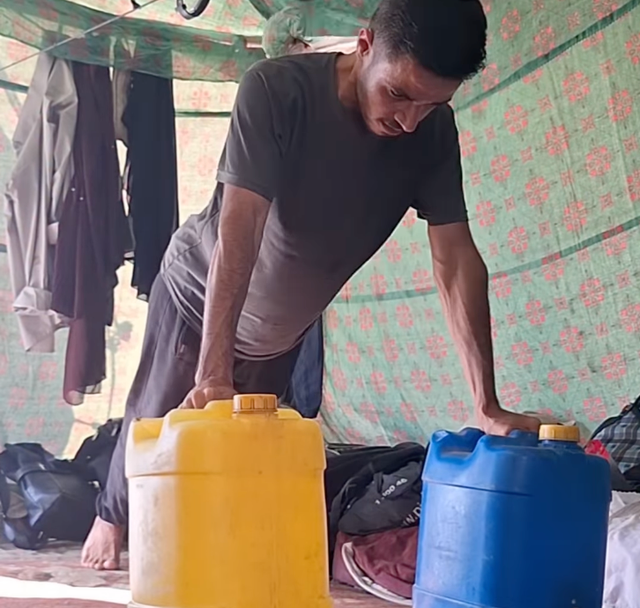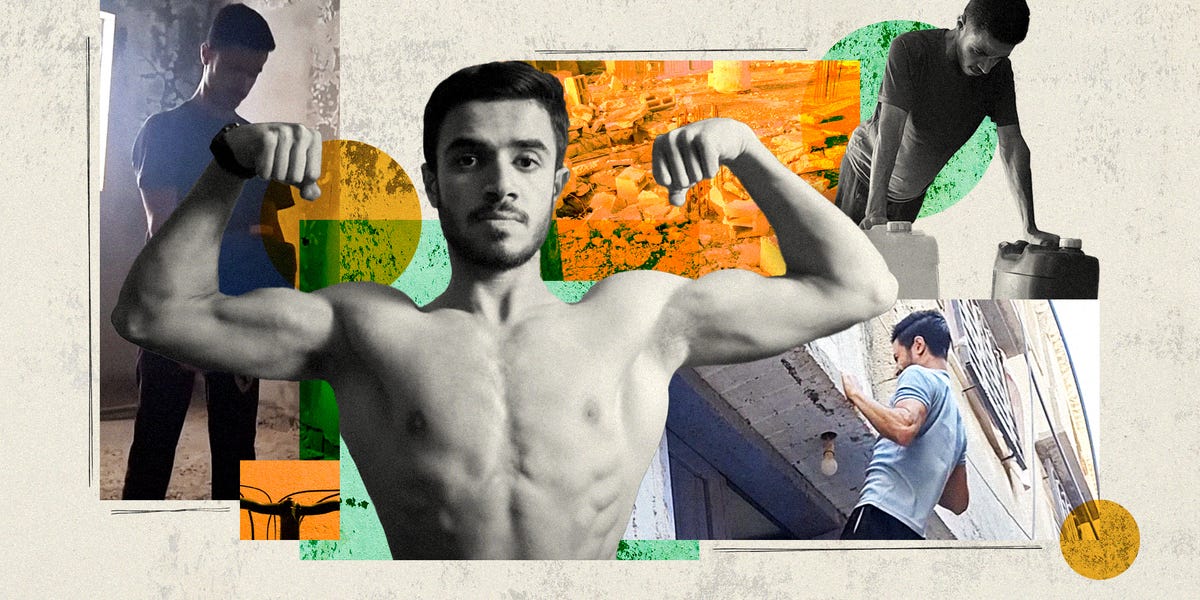MOHAMMED HATEM’S POSTS have all the signifiers of self-produced fitness influencer content: front-facing camera confessionals, plenty of workout footage, and meals broken down by macros. He takes part in viral trends, like when he created his own version of influencer Ashton Hall’s now-infamous morning routine video. He joked about how much cheap workout clothes would cost with unpredictable tariffs. Hatem even has a catchphrase he uses to start every video: “Let’s get it.”
Plenty of aspirationally fit young men around the world have set out to make it big on the internet with a smartphone and basic video production software. The difference is that Hatem hasn’t stepped foot in a gym in months. He struggles to eat enough to maintain his sinewy frame, let alone make gains. Sometimes, his videos are punctuated by the sound of gunfire and bombs. He’s a 19-year-old Palestinian kid living in Gaza, posting on Instagram with the handle @gym_rat_in_gaza.
Hatem’s workout origin story is a familiar one: He was a skinny kid looking for a way to build up his body and bolster self-confidence. “My first inspiration to fitness was a personal feeling of wanting to get better, you know, be better,” he says, recalling that he weighed around 40 kilograms (roughly 100 pounds) as a young teen when he started working out in 2022. “One of the aspects of my life that I really wanted to improve was my physical health, my physical strength, and appearance.” Researching how to accomplish this led him to the world of online bodybuilding. He cites figures like Jeff Nippard, Sam Sulek, and Chris Bumstead as sparking his interest at the time.
He was just two weeks into his studies in business administration at the Khan Yunis campus of Al Aqsa University, in the south of Gaza, when Israel began its bombardment. He shifted to an online program through the University of Palestine, but as conditions around him worsened, he had to put his education on hold.
Hatem needed a new focus while he wasn’t in school. Before, he had been extremely disciplined in the gym—”I was locked in back then”—so he shifted his approach to workouts, just as he and his family adjusted to life without reliable access to basic essentials.
“Just a few days before I started documenting my journey, I got the news that my house was destroyed,” he recalls. “Despite all of this going on, I was still working out every day.” So he began recording his daily sessions in earnest. He made a series for the first 100 days to share his progress—culminating in an impressive muscle transformation by October 2024, even as his access to the gym was increasingly inconsistent and food was becoming scarce. Then, he kept posting.
“I can figure out a way to work out, no matter where you put me, no matter where I go, no matter what place I’m staying in, I’m gonna find two or three exercises that I can do,” he says. In Hatem’s videos, viewers see how he’s had to lean on ingenuity. One clip, responding to a prompt asking “What’s the craziest place you’ve worked out in?” shows the different platforms he’s used for pullups, with footage of him hanging from door frames and exposed rebar in the rubble of a bombed-out building.
“I would find a little edge somewhere, and that would be my pull up bar. I would find a water gallon, and that’s my dumbbells. It’s just about looking around and seeing what stuff has a progressive overload potential.”
In one Instagram Reel, Hatem mentions bodybuilder Jeff Nippard as he performs deficit pushups using a pair of water jugs as platforms, stretching his chest muscles with the extended range of motion, his nose nearly touching the concrete floor. Turn on the audio, and you can hear him straining to press himself up from the bottom position. You can also hear the loud buzz of what sounds like a drone.
“There’s no place for excuses,” he says, echoing a common refrain heard in the fitness world. “Whatever you’re going through, there’s always room for improvement, and you’ve got to take that.”
In a video posted in May, he prepares a meal and shows a 25 kg sack of flour. He asks viewers to guess how expensive it was. After the reveal—$180—he jokes: “This should be put in a museum as the most expensive bag of flour in history.”

Mohamed Hatem
In a reel from July, he’s back at it on the water jugs. He stops, stands up, and the camera switches to first person. The screen darkens, simulating a blackout. The caption reads “POV: you decided to work out but forgot you’re in GAZA (I had 200 calories so far)”.
Besides his family’s home, Hatem says that his grandmother’s house has been destroyed, too. They’ve been displaced 13 times. He says he’s currently living in a tent on the beach in Khan Yunis, with his parents and two younger brothers.
“The situation with the food,” he says, “it’s no secret that it’s the toughest it’s ever been.” Naturally, this has impacted his training. “Normal people, they don’t look at the nutrition thing, as calories and protein and carbohydrates and stuff—they just look at it as fuel for the day,” he says. “And I would say, everyone around me has taken the same hit that I have taken.” He’s especially concerned for those around him who aren’t healthy would-be bodybuilders—like his grandmother, a cancer survivor. On his Instagram, he regularly posts links to fundraisers to help his family and other Gazans buy food.
“When you look at starvation physiology, the severe caloric restriction that usually happens with famine, there’s going to be a lot of muscle loss,” says MH Advisor Dezi Abeyta, RDN. “There’s going to be some weakness, suppressed immune function.”
Hatem has approached the challenges just as he has with those that came before: from a fitness mindset. “A rule that I’ve been following [for workouts] since all this started here in Gaza is: Sacrifice the volume, keep the intensity,” he says in a post. This is an approach taken by bodybuilders, who restrict calories to achieve extremely low body fat before a competition—but it’s not necessarily healthy, especially for extended periods. “When we look at severe malnutrition and muscle wasting and the types of severe caloric restriction, generally speaking, these have to be short term.” Abeyta says. “We could be looking at electrolyte imbalances, cardiac issues, and respiratory distress. These are all symptoms that we want to watch out for when someone is under a severe calorie restriction.”
Hatem’s profile has caught on; he currently has nearly 350,000 Instagram followers, and his story has been covered by Al Jazeera and MSNBC’s Chris Hayes, among others. In a December interview with WBUR Here & Now host Deepa Fernandes, he said:
“I get a lot of messages from people telling me that they started going to the gym because of watching me and they got motivated by my journey and my content to start their own fitness journey. It makes me feel really proud and honored to be the reason for all of this.”
Even with the uncertainty, Hatem has high hopes for the future. “Whenever things are pretty stable again, I’m gonna be back to it, Inshallah,” he says of his university studies. He hopes to shift his focus to subjects that will help him in his fledgling online fitness coaching career—like nutrition. This year, he started things up with five clients, most of them based in Europe. In May, he poked fun at the fact that he’s a coach who’s not always able to practice what he preaches, given he’s rarely able to meet his daily protein goal. Still, he remains excited by the thought of scaling up his business.
When it comes to reflecting on his efforts, Mohammed Hatem zooms out. “So for my journey, it’s mostly to motivate people to be a better version of themselves—and to also show that us Gazans would never give up on our dreams, no matter how tough the conditions are, no matter how tough the circumstances are.”
“When you read about us in the news, they would be like, a Gazan was this, this and that,” he says. “But when it comes to thinking about a Gazan that is going on a fitness journey and has goals just like everyone else… it gives a feeling of connection between us.”
And his posts, etched onto the internet for as long as Meta and Google allow? “When I look back at it, that’s a recap of the entire year that I went through with all the conditions, all the displacement, the nutrition, the training—everything is just there. And then you’re going to see the results of it later on.”
Brett Williams, NASM-CPT, PES, a senior editor at Men’s Health, is a certified trainer and former pro football player and tech reporter. You can find his work elsewhere at Mashable, Thrillist, and other outlets.

